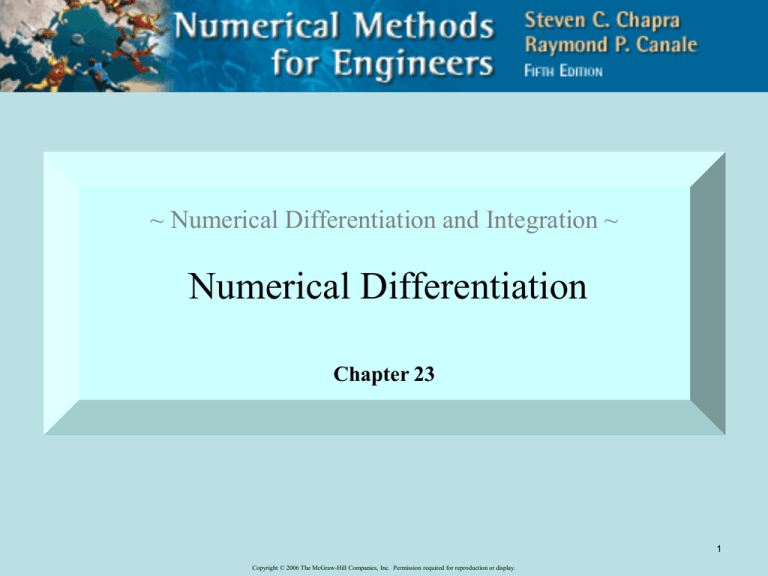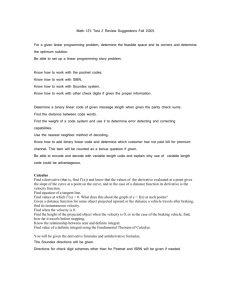CHAP-23e
advertisement

~ Numerical Differentiation and Integration ~ Numerical Differentiation Chapter 23 1 Copyright © 2006 The McGraw-Hill Companies, Inc. Permission required for reproduction or display. High Accuracy Differentiation Formulas • High-accuracy divided-difference formulas can be generated by including additional terms from the Taylor series expansion. f ( xi ) 2 h 2 f ( xi 1 ) f ( xi ) f ( xi ) f ( xi ) h h 2 f ( xi 1 ) f ( xi ) f ( xi )h f ( xi ) f ' ( xi 1 ) f ' ( xi ) f ( xi 2 ) 2 f ( xi 1 ) f ( xi ) O ( h) h h2 f ( x i 1 ) f ( x i ) f ( x i 2 ) 2 f ( x i 1 ) f ( x i ) 2 h O ( h ) 2 h 2h f ( x i 2 ) 4 f ( x i 1 ) 3 f ( x i ) f ( x i ) O( h2 ) 2h f ( x i ) • Inclusion of the 2nd derivative term has improved the accuracy to O(h2). • Similar improved versions can be developed for the backward and centered formulas Copyright © 2006 The McGraw-Hill Companies, Inc. Permission required for reproduction or display. Forward finite-divided-difference formulas First Derivative f ( xi 1 ) f ( xi ) f ( xi ) h f ( xi 2 ) 4 f ( xi 1 ) 3 f ( xi ) f ( xi ) 2h Error Second Derivative f ( xi 2 ) 2 f ( xi 1 ) f ( xi ) f " ( xi ) h2 f ( xi 3 ) 4 f ( xi 2 ) 5 f ( xi 1 ) 2 f ( xi ) f " ( xi ) h2 Error Copyright © 2006 The McGraw-Hill Companies, Inc. Permission required for reproduction or display. O(h) O(h2) O(h) O(h2) Backward finite-divided-difference formulas First Derivative f ( xi ) f ( xi 1 ) f ( xi ) h 3 f ( xi ) 4 f ( xi 1 ) f ( xi 2 ) f ( xi ) 2h Error Second Derivative f ( xi ) 2 f ( xi 1 ) f ( xi 2 ) f " ( xi ) h2 2 f ( xi ) 5 f ( xi 1 ) 4 f ( xi 2 ) f ( xi 3 ) f " ( xi ) h2 Error Copyright © 2006 The McGraw-Hill Companies, Inc. Permission required for reproduction or display. O(h) O(h2) O(h) O(h2) Centered finite-divided-difference formulas First Derivative f ( xi 1 ) f ( xi 1 ) f ( xi ) 2h f ( xi 2 ) 8 f ( xi 1 ) 8 f ( xi 1 ) f ( xi 2 ) f ( xi ) 12h Error Second Derivative f ( xi 1 ) 2 f ( xi ) f ( xi 1 ) f " ( xi ) h2 f ( xi 2 ) 16 f ( xi 1 ) 30 f ( xi ) 16 f ( xi 1 ) f ( xi 2 ) f " ( xi ) 12h 2 Error Copyright © 2006 The McGraw-Hill Companies, Inc. Permission required for reproduction or display. O(h2) O(h4) O(h2) O(h4) Derivation of the centered formula for f’’(xi) f ( xi ) 2 f ( xi 1 ) f ( xi ) f ( xi )h h 2 2( f ( xi 1 ) f ( xi ) f ( xi )h) f ( xi ) h2 f ( xi 1 ) f ( xi 1 ) 2( f ( xi 1 ) f ( xi ) h) 2h h2 2 f ( xi 1 ) 2 f ( xi ) f ( xi 1 ) f ( xi 1 ) h2 f ( xi 1 ) 2 f ( xi ) f ( xi 1 ) f ( xi ) h2 Copyright © 2006 The McGraw-Hill Companies, Inc. Permission required for reproduction or display. Differentiation Using MATLAB x f(x) i-2 0 1.2 i-1 0.25 1.1035 i 0.50 0.925 i+1 0.75 0.6363 i+2 1 0.2 First, create a file called fx1.m which contains y=f(x): function y = fx1(x) y = 1.2 - .25*x - .5*x.^2 - .15*x.^3 -.1*x.^4 ; Command window: >> x=0:.25:1 0 0.25 >> y = fx1(x) 1.2 0.5 1.1035 0.925 0.6363 >> d = diff(y) ./ diff(x) d = 0.75 -0.3859 Forward: x = 0 Backward: x = 0.25 1 0.2 % diff() takes differences between % consecutive vector elements -0.7141 -1.1547 0.25 0.50 Copyright © 2006 The McGraw-Hill Companies, Inc. Permission required for reproduction or display. 0.50 0.75 -1.7453 0.75 1 1 Example : f(x) = -0.1x4 – 0.15x3 – 0.5x2 – 0.25x + 1.2 f’(x) = -0.4x3 – 0.45x2 – x – 0.25 At x = 0.5 True value for First Derivative = -0.9125 Using finite divided differences and a step size of h = 0.25 we obtain: x f(x) i-2 0 1.2 i-1 0.25 1.1035 Estimate i 0.50 0.925 εt (%) i+1 0.75 0.6363 i+2 1 0.2 Forward difference of accuracy O(h2) is computed as: 0.2 4(0.6363) 3(0.925) f (0.5) 0.8593 2(0.25) Backward difference of accuracy O(h2) is computed as: 3(0.925) 4(1.1035) 1.2 f (0.5) 0.8781 2(0.25) Forward O(h) Backward O(h) -1.155 -0.714 26.5 21.7 t 5.82% t 3.77% Copyright © 2006 The McGraw-Hill Companies, Inc. Permission required for reproduction or display. 8 Richardson Extrapolation • There are two ways to improve derivative estimates when employing finite divided differences: – Decrease the step size, or – Use a higher-order formula that employs more points. • A third approach, based on Richardson extrapolation, uses two derivative estimates (with O(h2) error) to compute a third (with O(h4) error) , more accurate approximation. We can derive this formula following the same steps used in the case of the integrals: 4 1 h2 h1 / 2 D D(h2 ) D(h1 ) 3 3 Example: using the previous example and Richardson’s formula, estimate the first derivative at x=0.5 Using Centered Difference approx. (with error O(h2)) with h=0.5 and h=0.25 : Dh=0.5(x=0.5) = (0.2-1.2)/1 = -1 Dh=0.25(x=0.5) = (0.6363-1.103)/0.5=-0.9343 [ εt=|(-.9125+1)/-.9125| = 9.6% ] [ εt=|(-.9125+0.9343)/-.9125| = 2.4%] The improved estimate is: D = 4/3(-0.9343) – 1/3(-1) = -0.9125 [ εt=(-.9125+.9125)/-.9125 = 0% perfect!] 9 Copyright © 2006 The McGraw-Hill Companies, Inc. Permission required for reproduction or display. Derivatives of Unequally Spaced Data • Derivation formulas studied so far (especially the ones with O(h2) error) require multiple points to be spaced evenly. • Data from experiments or field studies are often collected at unequal intervals. • Fit a Lagrange interpolating polynomial, and then calculate the 1st derivative. As an example, second order Lagrange interpolating polynomial is used below: x xi x xi 1 xi 1 xi xi 1 xi 1 x xi 1 x xi 1 f ( xi ) xi xi 1 xi xi 1 x xi 1 x xi f ( xi 1 ) xi 1 xi 1 xi 1 xi f ( x) f ( xi 1 ) f ( x) f ( xi 1 ) 2 x xi xi 1 xi 1 xi xi 1 xi 1 2 x xi 1 xi 1 f ( xi ) xi xi 1 xi xi 1 f ( xi 1 ) 2 x xi 1 xi xi 1 xi 1 xi 1 xi *Note that any three points, xi-1 xi and xi+1 can be used to calculate the derivative. The points do not need to be spaced equally. 10 Copyright © 2006 The McGraw-Hill Companies, Inc. Permission required for reproduction or display. Example: The heat flux at the soil-air interface can be computed with Fourier’s Law: dT q( z 0) kC dz q = heat flux k = coefficient of thermal diffusivity in soil (≈3.5x10-7 m2/s) ρ = soil density(≈ 1800 kg/m3) o z 0 C = soil specific heat(≈ 840 J/kg . C ) *Positive flux value means heat is transferred from the air to the soil Calculate dT/dz (z=0) first and then and determine the heat flux. A temperature gradient can be measured down into the soil as shown below. MEASUREMENTS 2(0) 1.25 3.75 0 1.250 3.75 2(0) 0 3.75 12 1.25 01.25 3.75 2(0) 0 1.25 10 3.75 03.75 1.25 f ( z 0) 13.5 14.4 14.4 1.333 1.333 0C / cm which can be used to compute the heat flux at z=0: q(z=0) = -3.5x10-7(1800)(840)(-133.3 0C/m)=70.56 W/m2 Copyright © 2006 The McGraw-Hill Companies, Inc. Permission required for reproduction or display.




